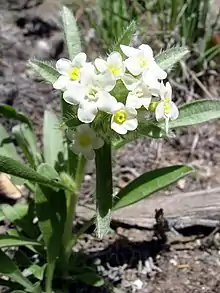| Greeneocharis circumscissa | |
|---|---|
 | |
| Scientific classification | |
| Kingdom: | Plantae |
| Clade: | Tracheophytes |
| Clade: | Angiosperms |
| Clade: | Eudicots |
| Clade: | Asterids |
| Order: | Boraginales |
| Family: | Boraginaceae |
| Genus: | Greeneocharis |
| Species: | G. circumscissa |
| Binomial name | |
| Greeneocharis circumscissa | |
| Synonyms[2] | |
| |
Greeneocharis circumscissa is a species of flowering plant in the borage family,[2] known by the common name cushion cryptantha. It is native to western North America from Washington to Baja California to Colorado and it is also found in Argentina.[3] It grows in sandy or gravelly types of habitat, from mountains to desert, below 9,500 m (31,200 ft) above sea level.[4]
This is an annual herb producing a short, bristly, multi-branched stem tangled into a mat no more than 10 centimeters tall. It grows from a red taproot which dries purple. The leaves are up to 1.5 centimeters long, linear to widely lance-shaped, and densely hairy to bristly. The inflorescence is a length of developing fruits with a dense cluster of up to 5 flowers at the tip. The flower has a five-lobed white corolla with yellow appendages at the top of its tube. It flowers between April and August.[4]
It was first published in Bull. Torrey Bot. Club vol.36 on page 677 in 1909.[2]
The Latin specific epithet circumscissa is derived from the Latin for "cut around" because the upper half of the fruiting calyx falls away when the nutlets are ripe.[5]
It has 3 known variants;[2]
- Greeneocharis circumscissa var. circumscissa
- Greeneocharis circumscissa var. hispida J.F.Macbr.
- Greeneocharis circumscissa var. rosulata (J.T.Howell) Hasenstab & M.G.Simpson
References
- ↑ NatureServe (2023). "Cryptantha circumscissa". Arlington, Virginia. Retrieved 9 November 2023.
- 1 2 3 4 "Greeneocharis circumscissa (Hook. & Arn.) Rydb". Plants of the World Online. Royal Botanic Gardens, Kew. Retrieved 9 November 2023.
- ↑ Thomas Henry Kearney and Robert Hibbs Peebles Flowering Plants and Ferns of Arizona (1942), p. 753, at Google Books
- 1 2 Philip Alexander Munz A California Flora (1959), p. 567, at Google Books
- ↑ "Page CI-CY". www.calflora.net. Retrieved 10 July 2022.
